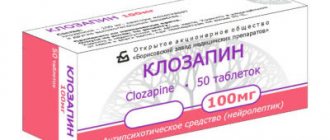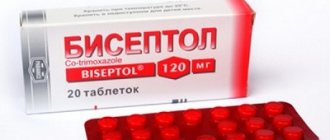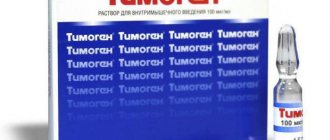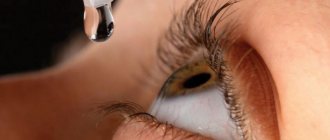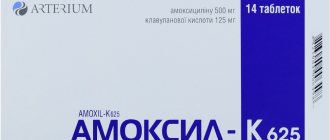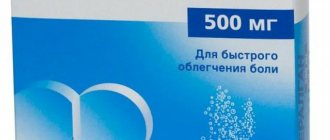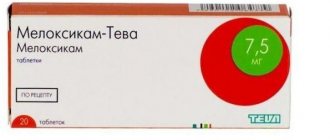Medicinal properties
“Cedex” is a strong antibiotic with a wide spectrum of action (pharmacological group - antibacterial, anti-inflammatory and bactericidal agent).
This antibiotic inhibits the synthesis of bacterial cell walls and affects many microorganisms that can resist penicillins.
Immediately after administration, the drug is completely absorbed into the blood. Bioavailability is almost 94%.
The medicine is excreted by urine and kidneys.
Instructions:
Clinical and pharmacological group
06.010 (III generation cephalosporin)
Release form, composition and packaging
Capsules are white or yellowish-white; the contents of the capsules are white or yellowish powder.
| 1 caps. | |
| ceftibuten | 400 mg |
Excipients: microcrystalline cellulose, sodium starch glycolate, magnesium stearate.
Capsule shell composition: sodium lauryl sulfate, titanium dioxide, gelatin.
1 PC. - bags (5) - cardboard boxes.
Powder for the preparation of a suspension for oral administration from light yellow to dark yellow; in water it forms a light yellow suspension with a characteristic cherry odor.
| 1 ml of ready-made suspension. | |
| ceftibuten (dihydrate) | 36 mg |
Excipients: xanthan gum, sucrose, simethicone, silicon dioxide, titanium dioxide, polysorbate 80, sodium benzoate, cherry flavor.
Dark glass bottles with a volume of 30 ml (1) complete with a dosing spoon and a measuring cup - cardboard packs. Dark glass bottles with a volume of 60 ml (1) complete with a dosing spoon and a measuring cup - cardboard packs.
pharmachologic effect
III generation cephalosporin. It is a beta-lactam antibiotic, has a bactericidal effect, the mechanism of which is due to the suppression of the synthesis of the bacterial cell wall. The drug acts on many microorganisms that produce β-lactamases and are resistant to penicillins and other cephalosporins.
Ceftibuten is highly resistant to plasmid penicillinases and cephalosporinases. However, it is destroyed by the action of some chromosomal cephalosporinases, which are produced by microorganisms such as Citrobacter spp., Enterobacter spp. and Bacteroides spp. The drug should not be used for infections caused by bacterial strains whose resistance to beta-lactam antibiotics is due to common mechanisms, such as changes in permeability or penicillin-binding proteins (PBPs) (for example, penicillin-resistant Streptococcus pneumoniae). Ceftibuten interacts mainly with PSB-3 of Escherichia coli, which leads to the formation of filamentous forms at a concentration of 1/4-1/2 MIC, and lysis at a concentration twice the MIC. The minimum bactericidal concentration of ceftibuten for Escherichia coli strains sensitive and resistant to ampicillin is approximately equal to the MIC.
Active in vitro and in clinical practice against most strains of the following gram-positive microorganisms: Streptococcus pyogenes, Streptococcus pneumoniae (except for penicillin-resistant strains); gram-negative microorganisms: Haemophilus influenzae (strains producing and not producing β-lactamases), Haemophilus parainfluenzae (strains producing and not producing β-lactamases), Moraxella (Branhamella) catarrhalis (most strains produce β-lactamases), Escherichia coli, Klebsiella spp . (including Klebsiella pneumoniae and oxytoca), indole-positive Proteus spp. (including Proteus vulgaris), as well as Providencia spp., Proteus mirabilis, Enterobacter spp. (including Enterobacter cloacae and Enterobacter aerogenes), Salmonella spp., Shigella spp.
It is active in vitro against most strains of the following microorganisms, but its clinical effectiveness has not been established; gram-positive microorganisms: Streptococcus spp. groups C and G; gram-negative microorganisms: Brucella spp., Neisserria spp., Aeromonas hydrophilia, Yersinia enterocolitica, Providencia rettgeri, Providencia stuartii and strains of Citrobacter spp., Morganella spp. and Serratia spp., which do not produce large quantities of chromosomal cephalosporinases.
Inactive against Staphylococcus spp., Enterococcus spp., Acinetobacter spp., Listeria spp., Flavobacterium spp. and Pseudomonas spp., weakly active against most anaerobes, including most Bacteroides strains.
Ceftibuten-trans does not have microbiological activity in vitro or in vivo against the same strains.
Pharmacokinetics
Suction
After taking the drug orally, ceftibuten is almost completely absorbed from the gastrointestinal tract (90%). In one study, plasma Cmax after a single oral dose of ceftibuten 200 mg capsule averaged approximately 17 mcg/mL. Cmax in plasma was achieved 2 hours and 3 hours after a single oral dose of 200 mg and 400 mg capsules.
The bioavailability of ceftibuten is dose dependent over the therapeutic dose range (≤400 mg). The rate and extent of absorption of ceftibuten when taking Cedex in the form of a suspension changes when taken simultaneously with food. Concomitant food intake does not affect the effectiveness of Zedex in capsule form.
Distribution
The degree of binding of ceftibuten to plasma proteins is low (62-64%). Css of ceftibuten (when administered every 12 hours) in plasma are achieved after taking the fifth dose. No noticeable accumulation of the drug was observed upon repeated use.
Ceftibuten easily penetrates into liquid media and body tissues. In the skin bladder fluid, the concentration of ceftibuten is comparable to or higher than that in plasma (comparison based on AUC). Ceftibuten penetrates into the middle ear fluid of children with acute otitis media, where its concentration is approximately equal to or greater than plasma levels. Ceftibuten concentrations in lung tissue are approximately 40% of plasma concentrations. In nasal, tracheal and bronchial secretions, broncho-alveolar lavage fluid and its cellular suspension, ceftibuten concentrations are approximately 46, 20, 24, 6 and 81% of plasma concentrations, respectively.
There are no adequate data on the concentration of ceftibuten in the cerebrospinal fluid, but when other cephalosporins are taken orally, their concentration in the cerebrospinal fluid usually does not reach therapeutic levels.
Metabolism and excretion
The main ceftibuten derivative circulating in plasma (ceftibuten-trans) appears to be formed by direct conversion of ceftibuten (cis form). The concentration of ceftibuten-trans in plasma or urine is usually about 10% or less of the concentration of ceftibuten.
T1/2 of ceftibuten from plasma ranges from 2 to 4 hours (average 2.5 hours) and does not depend on the dose or regimen. It is excreted mainly unchanged in the urine. Ceftibuten is detectable in urine within 24 hours after taking 400 mg; Cmax in urine is 264 mcg/ml and is achieved within the first 4 hours; 20-24 hours after a single dose of the drug, the concentration of ceftibuten in the urine is 10.5 mcg/ml.
Pharmacokinetics in special clinical situations
In elderly people, Css of ceftibuten (when taken every 12 hours) is achieved after taking the fifth dose. The mean AUC in this group was slightly higher than in young adults. With repeated use of ceftibuten in elderly patients, accumulation was insignificant.
In mild renal failure, the pharmacokinetics of Zedex do not change significantly.
Dosage
The average duration of therapy is from 5 to 10 days. When treating infections caused by Streptococcus pyogenes, Cedex in a therapeutic dose should be used for at least 10 days.
For adults, the recommended dose of Cedex is 400 mg/day. Zedex capsules can be taken regardless of food. For acute bacterial sinusitis, acute bronchitis, exacerbation of chronic bronchitis and complicated and uncomplicated urinary tract infections, the drug can be used in a dose of 400 mg 1 time / day.
For community-acquired pneumonia and the possibility of taking the drug orally, the recommended dose of Cedex is 200 mg every 12 hours.
In adult patients with impaired renal function, a dose change is required only when CC decreases to less than 50 ml/min. With CC from 49 to 30 ml/min, the daily dose should be reduced to 200 mg or prescribed 400 mg every 48 hours (every other day); with CC from 29 to 5 ml/min, the recommended daily dose is 100 mg or the drug is prescribed at 400 mg every 96 hours (every 3 days). In patients receiving hemodialysis treatment 2 or 3 times a week, Cedex can be prescribed 400 mg at the end of each hemodialysis session.
For children, it is preferable to administer the drug in the form of a suspension; the recommended dose is 9 mg/kg/day. The maximum dose is 400 mg/day. For pharyngitis (including tonsillitis), acute purulent otitis media and urinary tract infections (including complicated ones), the drug can be used once a day.
For acute bacterial enteritis in children, the daily dose can be divided into 2 doses (at the rate of 4.5 mg/kg every 12 hours).
Children weighing more than 45 kg or aged more than 10 years can be prescribed the drug at the recommended dose for adults.
The safety and effectiveness of Cedex in children under 6 months of age have not been established.
Tsedex suspension can be taken approximately 1-2 hours before or after meals. Before taking the drug, the bottle with the prepared suspension should be shaken vigorously.
Rules for preparing a suspension for oral administration
Measure the required amount of water (25 ml) by pouring water into a measuring cup (included in delivery) to the level of the hole. Pour approximately half of the measured water into the bottle with the powder and shake to moisten the powder well, then add the remaining amount of water into the bottle and shake thoroughly again until the powder is completely dissolved and 30 ml of a homogeneous suspension is obtained. For more accurate dosing of the prepared suspension, it is recommended to use the dosing spoon included in the kit and having graduations for 45 mg, 90 mg, 135 mg and 180 mg of suspension.
Overdose
In case of accidental overdose of Cedex, no signs of toxicity were noted. In healthy adult volunteers who received a single dose of Cedex up to 2 g, there were no serious adverse reactions, and all clinical and laboratory parameters remained within normal limits.
Treatment: there is no specific antidote for ceftibuten, so in case of overdose, gastric lavage can be performed. A significant portion of the Cedex dose can be removed from the blood using hemodialysis. The effectiveness of peritoneal dialysis has not been established.
Drug interactions
In special studies, the interaction of Cedex with the following drugs was studied: antacids containing aluminum and magnesium hydroxides in high doses, ranitidine and theophylline (single intravenous administration). There were no signs of clinically significant interaction. The effect of Cedex on plasma levels or the pharmacokinetics of theophylline when administered orally is not known. No information on interactions with other drugs has been received to date.
Use during pregnancy and lactation
Adequate and strictly controlled studies of the safety and effectiveness of the drug during pregnancy and childbirth have not been conducted.
The results of studies of the effect of drugs on reproductive function in animals do not always predict their effects in humans, therefore, when deciding whether to prescribe Cedex during pregnancy, the expected benefit to the mother and the potential risk to the fetus should be assessed.
Ceftibuten is not detected in breast milk.
Side effects
Adverse events reported in patients who received Cedex
From the digestive system: nausea (≤3%), diarrhea (3%); rarely - dyspepsia, gastritis, vomiting, abdominal pain, increased activity of AST, ALT and LDH; very rarely - the growth of Clostridium difficile, combined with moderate or severe diarrhea.
From the side of the central nervous system: headache, rarely - dizziness; very rarely - convulsions.
From the hematopoietic system: very rarely - decreased hemoglobin levels, leukopenia, eosinophilia, thrombocytosis.
Most of the adverse events associated with taking Zedex are usually moderate and transient, amenable to symptomatic therapy or disappear after discontinuation of Zedex.
Adverse events reported in patients treated with various cephalosporins
Allergic reactions: anaphylaxis, bronchospasm, shortness of breath, rash, urticaria, hypersensitivity reactions, itching, angioedema, Stevens-Johnson syndrome, erythema multiforme, toxic epidermal necrolysis.
From the digestive system: severe diarrhea, colitis (associated with antibiotic treatment, including pseudomembranous colitis), increased bilirubin levels.
From the hematopoietic system: aplastic anemia, pancytopenia, neutropenia and agranulocytosis.
From the blood coagulation system: increased prothrombin time and international normalized ratio (MHO), hemolytic anemia and internal bleeding, positive direct Coombs test.
From the urinary system: kidney dysfunction, toxic nephropathy, glucosuria, ketonuria.
Other: superinfection.
Storage conditions and periods
The drug should be stored out of the reach of children at a temperature of 2° to 25°C. The finished suspension can be stored for 14 days in the refrigerator (at a temperature of 2° to 8°C). Shelf life: 2 years.
Indications
Treatment of infectious and inflammatory diseases caused by sensitive microorganisms:
- infections of the upper respiratory tract (including pharyngitis, tonsillitis and scarlet fever in adults and children, acute sinusitis in adults, otitis media in children);
- infections of the lower respiratory tract in adults (including acute bronchitis, exacerbation of chronic bronchitis and acute pneumonia) in cases where the drug can be taken orally, i.e. for community-acquired infections;
— urinary tract infections in adults and children (including complicated and uncomplicated);
— enteritis and gastroenteritis in children caused by Salmonella spp., Shigella spp. and Escherichia coli (ceftibuten is not active against Campylobacter spp. and Yersinia spp.).
Contraindications
- children up to 6 months;
- hypersensitivity to the components of the drug and to other cephalosporins.
Cedex should be prescribed with caution to patients with complicated gastrointestinal diseases, especially chronic colitis (history), and also with extreme caution to patients with a known or suspected allergy to penicillins.
special instructions
Approximately 5% of patients allergic to penicillin have cross-reactivity to cephalosporins. Serious acute hypersensitivity reactions (anaphylaxis) have been reported in patients receiving penicillins and cephalosporins concomitantly; There are known cases of cross-hyperreactivity with the development of anaphylaxis. If serious anaphylactic reactions occur, emergency treatment is indicated (eg, epinephrine, IV fluids, airway management, oxygen, antihistamines, corticosteroids, pressor amines, active surveillance).
When treated with broad-spectrum antibiotics (including Cedex), disruption of the intestinal microflora can lead to diarrhea, including pseudomembranous colitis associated with the production of Clostridium difficile toxin. The severity of diarrhea, with or without dehydration, can range from moderate to severe or life-threatening. Diarrhea may occur during or after antibiotic treatment. This diagnosis must be discussed in all cases where persistent diarrhea occurs while taking any broad-spectrum antibiotic such as Cedex.
Cephalosporins, including Cedex, in rare cases may reduce prothrombin activity, resulting in an increase in prothrombin time, especially in patients previously stabilized on oral anticoagulant therapy. In patients at risk, prothrombin time and MHO should be monitored. If necessary, vitamin K supplementation is recommended.
There was no effect of Cedex on the results of chemical or laboratory tests. When using other cephalosporins, a false-positive direct Coombs test was sometimes recorded. However, the results of studies using erythrocytes from healthy people did not confirm the ability of Zedex to cause a positive Coombs test in vitro, even at concentrations up to 40 μg/ml.
Use for renal impairment
In adult patients with impaired renal function, a dose change is required only when CC decreases to less than 50 ml/min. With CC from 49 to 30 ml/min, the daily dose should be reduced to 200 mg or prescribed 400 mg every 48 hours (every other day); with CC from 29 to 5 ml/min, the recommended daily dose is 100 mg or the drug is prescribed at 400 mg every 96 hours (every 3 days). In patients receiving hemodialysis 2 or 3 times a week, Cedex can be prescribed 400 mg at the end of each hemodialysis session.
Conditions for dispensing from pharmacies
The drug is available with a prescription.
“Cedex”, capsules
Cedex is available in the form of white capsules that contain yellow granules (dosage 400 mg per 1 piece).
1 cardboard pack contains 5 capsules.
Mode of application
The permissible daily dose for adults on “Cedex” capsules is 400 mg. You can take this antibiotic both before and after meals. For sinusitis, bronchitis, otitis media and sinusitis, the patient needs to drink 400 mg of the drug once a day.
For severe pneumonia, the medicine should be taken 200 ml every twelve hours (400 mg per day). The duration of treatment is five to seven days.
Patients who have severe kidney problems drink 400 mg of the drug every two days. The duration of treatment is determined by the attending physician individually for each patient.
Those patients who receive concomitant hemodialysis therapy take the drug in an amount of 400 mg at the end of each hemodialysis session.
For children, the permissible daily dose of the drug is 400 mg per day (capsules).
For acute otitis media, tonsillitis, sinusitis, and urinary tract infections, the permissible dose (400 mg) should be taken once a day for five days.
In case of acute enteritis, the daily dose should be divided into two doses (half a tablet every 12 hours).
The average price is from 500 to 570 rubles.
Overdose of the drug Cedex, symptoms and treatment
In case of accidental overdose of Cedex, no signs of toxicity were noted. In healthy adult volunteers who received Cedex once at a dose of up to 2 g, no serious adverse reactions were observed, all clinical and laboratory parameters remained within normal limits. Treatment . There is no specific antidote for ceftibuten. In such cases, gastric lavage may be indicated. A significant amount of Cedex can be removed from the blood using hemodialysis. The effectiveness of peritoneal dialysis has not been established.
Suspension “Tsedex”
The powder for preparing the suspension has a light cherry aroma. These granules are contained in dark glass bottles. Also, a dosing spoon is added to the powder.
Mode of application
Rules for preparing the suspension (for oral administration):
- Measure out the required amount of warm water (30 ml)
- Pour the water into the bottle with the powder and shake well
- When the powder is completely dissolved, add the same amount of water to it.
The prepared suspension should be drunk an hour before meals. Store in the refrigerator for up to twelve hours.
The dosage of the drug in the form of a suspension for adults is the same as in the form of capsules.
And for children, in the form of a suspension, the dose taken should be calculated as follows: for one kg of weight per day, take 9 ml of the suspension.
Interactions of the drug Cedex
Special studies have studied the interaction of Cedex with drugs such as antacids containing aluminum and magnesium hydroxide in high doses, ranitidine and theophylline (single intravenous administration). There was no evidence of a significant interaction. The effect of Cedex on plasma levels or the pharmacokinetics of theophylline when administered orally is not known. No data on interactions with other drugs have been received to date. Cephalosporins, including ceftibuten, may rarely reduce prothrombin activity, resulting in prolongation of prothrombin time, especially in patients who have previously received oral anticoagulant therapy and have reached a stable state. In patients at risk, prothrombin time or MNI should be regularly monitored and vitamin K administered if necessary. Interaction with food. Concomitant food intake does not affect the effectiveness of Zedex taken in capsules. However, the rate and extent of absorption of Cedex suspension may change under the influence of food. Effect on laboratory test results. There was no effect of Cedex on the results of chemical or laboratory tests. When using other cephalosporins, a pseudo-positive direct Coombs test was sometimes recorded. However, the results of studies using erythrocytes from healthy people did not confirm the ability of Zedex to give a positive Coombs test in vitro , even at concentrations up to 40 μg/ml.
Contraindications
“Cedex” should not be used if there are the following indications:
- Pregnancy and lactation
- The patient's age is up to six months (there is no data on the safety of the effect of “Cedex” on children under this age)
- Individual intolerance (allergy) to the active component of the drug
- Lactose and fructose intolerance
- Impaired glucose absorption.
During pregnancy and breastfeeding
It is not recommended to use “Cedex” during pregnancy, since there is no accurate data on the safety of the effect of the active substance on fetal development.
If treatment with this drug is necessary during lactation, it is better to stop breastfeeding so as not to harm the baby.
special instructions
With long-term use of broad-spectrum antibiotics, microorganisms may develop resistance to the drug.
Immediately discontinue the drug and initiate appropriate therapy if convulsions or an anaphylactic reaction develop.
Patients with diabetes mellitus should note that 1 teaspoon of Zedex suspension contains 1 g of sucrose.
Extreme caution is required when prescribing the drug to patients with allergic reactions (for example, bronchial asthma or hay fever), as they have an increased risk of severe hypersensitivity reactions.
Approximately 10% of patients allergic to penicillin have a cross-reaction to cephalosporins. When taking these drugs together, cases of hypersensitivity reactions (anaphylaxis) have been reported, and cases of cross-hyperreactivity with the development of anaphylaxis are also known. If serious anaphylactic reactions occur, emergency treatment is required (in particular, epinephrine, glucocorticosteroids; intravenous fluid administration, ensuring airway patency, oxygen administration, antihistamine therapy, monitoring over time).
Long-term use of Cedex, like other broad-spectrum antibiotics, causes disruption of the intestinal microflora, which can cause diarrhea, including pseudomembranous colitis caused by the production of Clostridium difficile toxin. In mild cases, it is recommended to discontinue treatment and take ion exchange resins (colestipol, cholestyramine), in severe cases, replacement of the loss of fluid, protein and electrolytes is required, and bacitracin, vancomycin or metronidazole is also prescribed. It is not recommended to take drugs that interfere with intestinal motility. The severity of diarrhea (with or without dehydration) can range from moderate to severe or even life-threatening. It can appear both during and after the end of treatment with the drug.
There is no data on the effect of Cedex on the ability to drive vehicles and other complex mechanisms, however, the possibility of developing dizziness and convulsions should be taken into account, in which it is necessary to refrain from these types of activities.
There is no data on the use of Cedex in pregnant women. Studies conducted on animals have not revealed any harmful effects of the drug on pregnancy, childbirth, embryonic and postnatal development. When prescribing Cedex to pregnant women, the expected benefit to the mother and the possible risk to the fetus should be weighed.
The drug is not found in the breast milk of lactating women, however, caution is required when prescribing Cedex to women during lactation. The expected benefit to the mother and the possible risk to the baby must also be weighed.
The powder for preparing the suspension contains sodium benzoate, which can provoke hypersensitivity reactions (inflammation of the skin, eyes, mucous membranes); in infants, the risk of jaundice increases.
Precautionary measures
This drug is prescribed with caution in the following cases:
- If you are allergic to penicillin
- For various gastrointestinal diseases
- If the patient is over 60 years old
- In the presence of severe chronic diseases
- With severe renal failure.
Due to the fact that this antibiotic can cause drowsiness and other disorders in the nervous system, during the period of treatment with it, it is better for the patient to refrain from driving vehicles and operating complex mechanisms that require attention and concentration.
Situations in which use is contraindicated
Not all people can use Cedex to treat bacterial diseases, as the drug has contraindications. It is better to familiarize yourself with them in advance so that no complications arise when using the suspension or capsules. The main contraindications include:
- A chronic form of colitis, accompanied by other complications that disrupt the functioning of the digestive system.
- Congenital pathologies that disrupt carbohydrate metabolism. Among them are slow absorption of galactose and problems with the absorption of fructose.
- High sensitivity to active substances added to the drug.
Side effects
"Cedex" can cause the following side effects:
In the digestive system:
- Loss of appetite and disturbances of taste and digestion
- Dysbacteriosis and vomiting
- Colitis, pancreatitis, gastritis and stomach ulcers
- Constipation
- Abdominal pain
- Cholestasis
In the nervous system:
- Head pain and dizziness
- Tinnitus
- Convulsions
- Drowsiness or, conversely, loss of sleep
- Irritability, depression
- Paresthesia
- Hyperkinesis
To learn how to easily get rid of tinnitus, read the article: tinnitus - treatment.
In the urinary system:
- Deterioration of the renal system
- Increased blood protein
- Candidiasis
Allergic manifestations:
- Eczema (wet, dry or seborrheic)
- Rash and itching on the skin
- Dermatitis
- Dyspnea
- Swelling of the face and limbs
- Erytherma
In the hematopoietic system:
- Hematuria
- Neutropenia
- Pancytopenia
- Thrombocytopenia.
Additional side effects:
- Anaphylactic shock
- Kidney dysfunction
- Prostration
- Deterioration of kidney function
- Internal bleeding
- Epidermal necrolysis.
For what diseases is it used in treatment?
To figure out when to use Cedex, you need to familiarize yourself with the indications for its use.
Angina
Many people use the medicine to get rid of the symptoms of sore throat. This disease occurs due to streptococci and is accompanied by a sore throat and cough.
Otitis
Another common pathology for which doctors prescribe Cedex is otitis media. As the disease progresses, the tissues of the ear become inflamed, which can cause hearing problems.
Pneumonia
This is a dangerous infectious disease that can be treated with regular use of Cedex. The development of pneumonia is indicated by coughing, deterioration in breathing and wheezing in the lungs.
Other cases
There are other diseases for which the drug is used. These include:
- infections affecting the genitourinary system;
- gastroenteritis;
- enteritis.
See also
Comparison of Suprax and Flemoxin Solutab, which is better for a child and an adult
Read
Analogs
“Cedex” has the following medicinal analogues:
"Augmentin"
SmithKline, UK Price from 265 to 2000 rub.
“Augmentin” has a pronounced antibacterial and bactericidal effect. Release form: powder for suspension, film-coated tablets.
pros
- Helps quickly cure infections of the skin, urinary system and respiratory tract
- Has a wide spectrum of action (bactericidal group of drugs).
Minuses
- Available only by prescription
- Due to the effect of the drug on the nervous system, they should stop driving during the period of treatment.
"Suprax"
Hikma Pharmaceuticals, Jordan, etc. Price from 558 to 800 rubles.
Main action: antibacterial, bactericidal. Composition: cefixime (active component). Available in capsules and granules for the preparation of a suspension.
pros
- “Suprax” is effective for the treatment of tonsillitis, bronchitis and pharyngitis
- Has a light strawberry aroma
Minuses
- “Suprax” is contraindicated for children under 6 months
- Contraindicated in case of intolerance to penicillin
- May cause side effects in the gastrointestinal tract.
"Ceftriaxone"
Rapharma/Sintez/Kraspharma, Russia, etc. Price from 20 to 1000 rubles.
“Ceftriaxone” has an antibacterial and bactericidal effect. The active substance in the composition is cephalosporin. Ceftriaxone is available in powder form for injection.
pros
- Ceftriaxone is good for treating respiratory diseases
- Effective for sinusitis
- Ceftriaxone helps with acute infections of the urinary system.
Minuses
- Ceftriaxone is contraindicated during breastfeeding
- May cause side effects in the nervous system.
Indications for use of the drug Cedex
Treatment of infections caused by microorganisms sensitive to the drug. Infections of the upper respiratory tract and ENT organs , including pharyngitis, tonsillitis, scarlet fever in adults and children; acute sinusitis in adults, otitis media in children. Lower respiratory tract infections in adults, including acute bronchitis, exacerbation of chronic bronchitis and acute pneumonia in cases where oral therapy is possible, that is, for community-acquired infections. Urinary tract infections in adults and children, including complicated and uncomplicated. Enteritis and gastroenteritis in children caused by Salmonella , Shigella or E. coli .
Consequences of overdosing
Not all patients strictly adhere to the recommended doses of medication, which leads to signs of overdose. They do not appear immediately, but after 2-3 days of using the drug in large quantities.
Failure to comply with doses causes severe nausea with vomiting and digestive disorders in the patient. Also, under the influence of the medication, headaches intensify.
To eliminate unpleasant symptoms, you will have to consult a doctor or rinse your stomach yourself.

